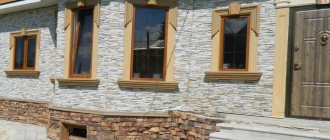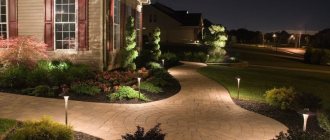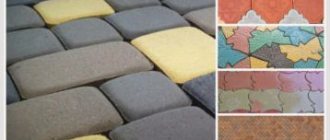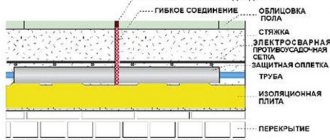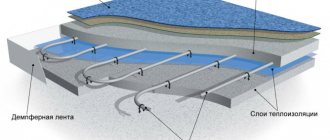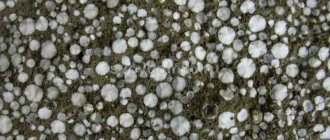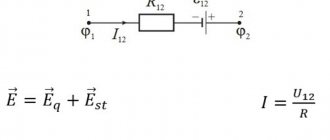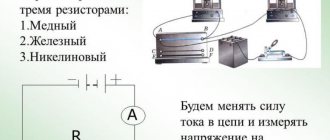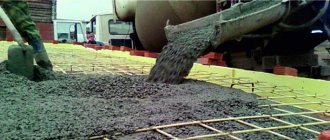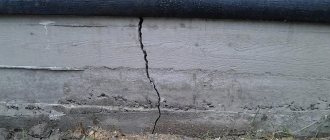Cement figurines: why they are good and how to make them
You can make garden figures from cement - this is one of the most used and affordable materials. It is inexpensive and allows you to create a wide variety of figures - from simple and small ones to full-length sculptures. There are several ways to make garden figures from cement mortar: with a frame, without it, from semi-dry mortar. More about everything later.
Very often mushrooms are made from concrete, but they are not always the same...
What to add to the solution
There are many additives to cement that improve/change its properties. There are a lot of them, but they are sold in fairly substantial volumes, which may only be needed for the manufacture of garden sculptures on an industrial scale. But there are ordinary substances that also change the properties of concrete mortar.
- PVA glue - increases the frost resistance of the finished product and the plasticity of the liquid solution. It fills the mold better, but “sets” faster. Dried cement with the addition of PVA can be processed much worse than regular cement. So don't waste time before it can be molded.
- Liquid glass - reduces water permeability, the solution sets faster. But it should be added no more than 1% of the total mass of the solution.
A not very common technique: the design is copied onto a semi-dry block of concrete, then scraped out with chisels or spoons. The main thing is to do it before the concrete becomes unyielding for processing. - Plasticizer is an additive that increases the plasticity of semi-dry (with a small amount of water) concrete mortar. You need to add very little, literally a teaspoon per bucket of solution.
- The addition of HYPERTUF will help make concrete lighter.
- Washing powder or dishwashing liquid - acts as a plasticizer and speeds up hardening. Add 0.5-1 teaspoon per bucket of solution.
- To make the surface of the figure smoother, it can be covered with putty. But putty is needed not for walls, but for wooden floors. After drying, it becomes very hard and adheres tightly to concrete.
These are the main additives that are needed when making concrete garden figurines. It's easier to work with them. But don't add too much. Maximum - one teaspoon per bucket, otherwise you will only make things worse.
How to paint and some technological nuances
After the concrete figure has dried, it must be sanded until smooth, the dust must be removed and it can be painted. In order for the paint to apply more evenly and consume less, you must first coat the product with a layer of primer. The primer is selected depending on the type of paint. The painting process itself is no different - you usually need brushes of different sizes. But it is worth knowing some features.
- Acrylic paints become brighter after varnishing.
- Can be painted with floor paint (enamel PF 115).
- Aerosol paints in cans are good - from automotive to interior. But the best option is for outdoor work. They last longer.
Regular floor paint holds up well - Can be painted with facade paint. They are precisely designed to withstand weather conditions. One problem - they are sold in large packages.
- In order for homemade garden figurines to better withstand precipitation, after the paint has dried, they must be coated with two or three layers of varnish. The best option is yacht varnish, but it is expensive and incompatible with acrylic paints (they have different bases). Acrylic paints require a water-based varnish, just be sure to use it for outdoor use. And look at the gloss level. There are glossy, matte, semi-matte.
- If molds are used to make garden figures, before filling they must be greased with oil (any kind, sunflower oil or technical oil) so that they come out easily.
This snake was “scraped out” from a concrete monolith - Before painting, sand the concrete with fine-grain sandpaper. In the process, sand that does not adhere too well is removed, and the surface becomes smoother.
- Animal fur can be made from an old artificial fur coat soaked in liquid concrete.
- Feathers or short hair can be imitated by adding long (or not so long) shavings to the solution.
There are still a lot of different technological nuances, but these are the main ones. The rest you will master or come up with as you work.
How to make garden figures: cutting from semi-dry mortar
It will not be possible to make garden figures from fresh cement-sand mortar - it is too liquid. Even if you mix it with a minimum of water, you won’t be able to form anything intelligible. But you can wait until the solution begins to harden, but remains quite soft - it will crumble under pressure. In this state, you can make grooves in it with a metal object and cut off the excess.
Blank for a monolith figure
From the thick mixture you can form the approximate shape of the intended character - put it in a piece of film, tie it, give it the desired shape. If you have a liquid solution, find a more or less suitable container or use the same film. The solution is left in the mold for 8-12 hours. The time depends on how liquid the cement was initially and the temperature at which you keep the product. The optimal temperature is about +20°C; at a lower temperature, the hardening time increases, and at a higher temperature, there is a possibility that the cement will dry out and not “set.”
Gradually a figure emerges from the block
Periodically check the condition of the workpiece: there should be a solid mass under your fingers, and when you apply more force, the cement is slightly pressed down. In this state, you can already begin to form the sculpture. You have 7-8 hours to work. For small figures this is more than enough, for large ones right next to each other you will have to hurry. To delay the drying of parts that are not yet being treated, you can wrap them in a wet cloth.
You can start with these decorative stones
Cute faces
It doesn’t have to be painted... You can cover it with colored glass or crockery shards
Another cute homemade figurine for the garden
This is how you can turn a small toy turtle into a garden figurine
Take a knife, wire, spatulas, and begin to cut off the excess little by little. There is no need to be afraid, if you remove something unnecessary, you can later add a little solution and correct it when it dries. In general, the technology is not too complicated, but if you don’t have artistic abilities, it’s difficult to come up with something intelligible yourself. For such cases, there is one trick: find a small figurine from any material, look at it and sculpt your own.
Casting complex shapes from a frame
More complex figures are made from the base frame, but the solution will have to be shaped independently. You can take any small flower bed as an example. You can take anything as a shape, for example, a pig.
- For the frame, take a ready-made container, wooden blocks simulating legs are attached to it with self-tapping screws, and the frame should also be secured in place of the head and tail in order to increase strength.
- A thick, creamy solution is mixed, and the frame is gradually coated with it.
- Then, using small lumps of the same solution, the figure is given the desired shape.
- Excess must be removed with hands soaked in water. At this stage, skills in working with materials and certain artistic inclinations are already required.
Complex figures are sculpted by professionals. They are based on a metal frame, which gives strength to the entire structure. The figure itself is either made by pouring mortar into a ready-made mold, or made individually by hand. In the latter case, the cost of the figure will be considerable.
You may be interested in: Beautiful design of a summer house and garden, arrangement of winter and summer gardens
Making cement figures with a base or frame
The technology for making garden figurines from concrete on a base consists of applying layer-by-layer mortar to the frame. But this technique is required when making large figures - about 150 cm or more. Then the bearing capacity of the concrete itself may not be enough. In this case, a rigid foundation is necessary. In other cases, a frame or base is needed only to minimize concrete consumption and reduce the overall weight of the product.
The frame for complex products is made (weaved or welded) from wire; for simpler ones, scrap materials are used. A 1-2 cm layer of mortar (thick) is applied to the finished frame, laid with a glass cloth mesh, the mortar is applied again, the mesh is again applied. The process alternates until your product takes the desired shape.
Example: wire turtle frame
Where and how to find the foundation
The main task is to find a vessel, bottle, box that is shaped to fit the intended product. If the shape is complex, it can be expanded or created entirely from pieces of foam. It is light and cuts well. But such figures - with a foam base - cannot withstand the load. If you expect that someone might sit on your products or have some other mechanical impact on them, it is better to use wooden blocks or foam concrete blocks instead of foam plastic. Foam concrete can be cut perfectly with a wood saw; it can be planed with a plane, a large knife, or made grooves with a sharp object. The principles of working with wood are known to everyone.
A frame may be needed if you want to recreate an exact copy of an animal or plant
The found form is covered with mortar, wrapped with rags, tow, ropes, and then also coated with cement. If the mortar layer is more than 2 cm, it is reinforced with a fiberglass mesh (serpyanka mesh is used for plastering walls). If plastic is used as a base, it is very difficult to apply the solution to it - it runs off. Such products are wrapped in rags soaked in a solution. After drying, the next layer is applied very well.
Grooves are made in the dried solution to indicate feathers and wool. In general, there are many techniques. Let's give a few examples to make it clearer how to make garden figures from concrete. Another option is to coat it with a solution into which the pebbles are pressed. It creates an uneven terrain.
Swans
For example, we want to make figures of swans. The basis for the body is a small round basin. The neck is a wire curved in the shape of the letter S. We attach the “neck” to the body in any available way.
Concrete swans
We apply a thick solution to the basin, forming the desired bend, add polystyrene foam, pieces of rags, etc. Leave to dry. We wrap rags soaked in the solution around the wire (it’s better to find a thicker one, you can use reinforcement). We fix and leave everything for a day. During this time, the concrete will set, and on the “body” you can use scraping to form wings, make grooves, draw feathers, etc.
Manufacturing process
We work closely on the neck and head. Apply the solution onto the resulting base with your hands (don’t forget to wear rubber gloves), forming a neck of the desired shape and thickness. You won’t be able to “build up” a lot at once - only in thin layers. When the neck becomes more like a real one, you can begin to form the feathers, outline the beak, eyes, etc. We leave the finished birds to dry for a week or more. Next - sanding, priming and painting.
Frog Princess
Using this example, we will demonstrate how you can make garden figurines from cement mortar and stones. A foam block was taken as a base, trimmed and hewn where necessary. The top is coated with a thick solution in several layers.
How to make garden figures: frog from concrete and stones
In the upper, still soft, layer, pebbles are reinforced - small flat pebbles; glass fragments are used on the crown. After drying, the figure is painted with acrylic paints and varnished twice.
DIY garden crafts made from cement and fabric: examples of decor
Simple options include concrete flowerpots. For example, by dipping an old rag into a liquid solution and hanging it on a bucket to dry, you can get an original garden pot.
Making garden vases from concrete and waste fabrics
Popular articles Bouquet for a lovely lady
Flowerpots and large stationary pots are made with two containers inserted into one another, between which the solution is poured. A semicircular flowerpot is obtained by applying cement to a balloon. Once dry, the additional elements are removed, and the inner or outer part (depending on how the flowerpot will be used) is painted.
The process of making a decorative pot from concrete and plastic containers
Original figures
With an inflatable balloon and some old rope, you can create some interesting DIY concrete garden crafts. These can be balls or monoliths (solution on the outer or inner part of the ball), rope products imitating the shape of a circle, original lighting with a small slot (candle tablets are placed in the center).
Making a garden figurine from rope dipped in concrete
Functional concrete products for the garden can be of a more complex design. For example, hands made of cement. This planter is made using rubber gloves filled with concrete mixture. A rod is inserted into each finger to provide rigidity and given the desired shape.
By creating figures of garden gnomes from cement and rags, you will not only diversify your free time, but also decorate your garden or yard.
Making figurines of garden gnomes from concrete and old clothes
Flowerpots from construction buckets are made using a plaster mesh wrapped on the outside, which is covered with cement. Before final hardening, you should decorate the product, for example, give it the outline of a stump. And inside you can place tall plants or small flowers. At the same time, the asymmetry of the vegetation location will only emphasize the naturalness of the pedestal.
Garden sculptures of mushrooms
Garden sculpture made of concrete can be either small in size (cats, ducklings, mushrooms, hedgehogs, fish, toads) or voluminous (hippos, crocodiles, turtles, camels, storks and swans). Mushrooms are made in several stages: a solution is poured into an unnecessary semicircular container (or into a rubber ball cut to the desired shape), then a plastic bottle without a neck is inserted, through which a retaining rod is threaded. The cavity of the bottle is filled with the mixture and left for several days to harden. The decoration can be colored pebbles or simple paint.
Manufacturing recommendations
Original flowerpots made from old shoes
Small products are best made with the addition of plastic gypsum or Portland cement. But you need to work quickly, the mixture hardens almost instantly. These materials are also often added to the cement mortar at the final stage. White cement is often used to create garden figurines.
Large structures are made with a frame. They can be old bowls, balls, which are pre-wrapped with plaster mesh and fixed to the frame with rods. Then cover with concrete mixture and allow to dry. Coating with fixing impregnations or dry pigment will add reliability and durability to the structure.
If the presence of small parts is expected, they are formed by applying a multi-layer mixture. This will require some sculpting skills. During the drying period, the figures are moistened with water so that the mixture adheres better. Priming is mandatory to give the product an aesthetic appearance. Such original cement figures can be successfully placed near ponds, alleys, in flower beds or directly at the entrance to the house. If desired, they can also be adapted for flowerpots.
A short video of creating a decorative pumpkin figurine from concrete
https://youtube.com/watch?v=TzfoviDc9L0%3F
Creating a rock garden requires the presence of boulders. An excellent alternative would be lightweight monolithic garden crafts made from concrete. The frame is any unnecessary material (foam plastic, scraps from a construction site, etc.). It is wrapped in mesh and thickly covered with a solution. The presence of irregularities is welcome, because the goal is to give visual naturalness.
Frameless technology: leaf drinker made of concrete
If the product is small or thin, and a large load is not planned on it, you can make it without a frame. Various types of bowls, slabs, and small sculptures are made this way. For example, a birdbath in the shape of a leaf. It can also be used as a stand for flowerpots and flowerpots, and other figures that are undesirable to come into contact with the ground.
We find a large leaf - burdock, rhubarb, etc. We place the sheet in water, form a flat slide from sand on a flat surface (table), and cover it with film.
Form the bowl in reverse
We lay out the sheet on a hill, pressing it into the sand. Mix the thick solution - it should not flow. The composition of the solution for sculptures is 1 part cement, 3 parts fine sand, you can add a plasticizer. Spread the solution on top of the sheet, pressing it tightly. In the middle the layer thickness is about 2 cm, towards the edges it becomes thinner - up to 1 cm. Form the edges carefully. It will be possible to straighten them, but this will not be so easy.
Coat the sheet with the solution
In the middle we insert a piece of plastic pipe with a diameter of about 10 cm and a length of 10-15 cm. Coat the joint with a solution and fill the pipe. Cover with plastic wrap. It protects against overheating, rain, and dirt. We press the edges with stones or something heavy, but there is no need to achieve tightness - excess moisture should evaporate.
Almost ready, just wait
Leave the garden sculpture without turning it over for at least 2 days. Then remove the outer film, carefully turn it over, and remove the sheet. If it does not come off, moisten it and wait a couple of minutes. Use a brush to remove residues and debris. Wait a few more days before painting - preferably two weeks.
This is what we got... an original birdbath
Before painting, sand with sandpaper and remove dust. If desired, you can coat it with a primer. Its type is selected according to the type of paint. A primer is needed so that the paint goes on more evenly and so that it is used less. When the paint dries, the product is coated with two layers of varnish. Choose varnish for exterior use. Better - matte or semi-matte.
Concrete home furniture options
To finally understand how wonderful concrete can be as a material for home furniture, let's look at a few photos with ready-made solutions from professional designers and craftsmen, supplementing them with our comments.
Concrete tennis table
- The first photo shows a simple concrete table for playing table tennis. Of course, there is no need to place such a structure inside the house due to its massiveness, but for a yard solution it would be ideal.
- Concrete is a material that is not afraid of water, capable of serving in wet conditions for a very long time, and when treated with waterproofing impregnations, it will not suffer from demolition at all. A concrete tennis table can be safely left in the open air, even in rain or snow.
Concrete countertop on wooden base
- If you want to fit a concrete table into a country style interior, then you should make a solid wooden base for it. These materials combine perfectly with each other in appearance.
- The surface of the tabletop has a textured pattern in the form of fern leaves. You will understand how to make such decor after reading the article - there is nothing complicated.
Composite table top – inlaid wood insert
- Having done the reinforcement correctly, you can make a tabletop for your beautiful table using inserts made of metal, glass and wood.
- Such combinations will also allow you to orient the product to the desired style and make it unique in its kind.
Concrete table base
This model has legs made of concrete
The solution is very massive, but outwardly very interesting. Please note that if a table has legs made of concrete rather than a tabletop, then its appearance becomes more urban, suitable for brutal loft-type styles. We observed exactly the opposite effect earlier when considering the option with a fern, so keep this feature in mind when designing.
Concrete table stylized as wooden
- Concrete is a plastic material, so elements of varying complexity can be cast from it, the main thing is to obtain or make suitable forms for this.
- In the above photo, the table is made entirely of concrete, with all the elements cast separately, which made it possible to create an interesting imitation of boards for the table top and spectacular carved legs, which had enough space for small flower beds.
- A similar creation in your yard will bring it closer to the romantic Renaissance or Mediterranean era.
Concrete sink
- This table doubles as a sink. Fine marble chips were added to the poured solution, which created a pleasant grainy effect.
- High-quality vibration and polishing made the surface smooth, and concrete varnish made it completely waterproof.
- Such surfaces go well with porcelain stoneware and other tiles, so fitting them into the interior of any bathroom will not be difficult.
Popular articles Happy birthday cards for men. more than 100 congratulations!
Kitchen furniture
In this case, not only the dining table is made of polished concrete, but also the countertop of the work area, which houses both the built-in sink and the gas hob.
Surface restored with concrete
Decorative figures made of polyurethane foam
You can make garden figurines from polyurethane foam very quickly and easily. Just keep in mind that they turn out to be very light, so some kind of weighting agents are needed. Plastic bottles, metal containers, cardboard boxes, etc. are suitable as bases. For thin parts - arms, legs, necks - any materials of the desired shape and size are suitable: branches, wire, wire frame, plastic pipes, metal corner, etc. and so on.
This is an Alpine goby made of polyurethane foam. Here there is no need to make special wool: the foam itself forms the desired relief
The basis for thin or strongly protruding parts of figures can be stuck in later - after the “body” is ready. You can simply stick a wire, a corner, a stick into the dried foam. If soft materials are used, they can be nailed down or screwed with self-tapping screws, secured with staples from a stapler, and glued. In general, use any available method.
It’s better not to skimp on the quality of foam - choose an expensive one. It does not flow like rising yeast dough, but increases in size, maintaining the shape specified when applied. But even with expensive polyurethane foam there is no need to rush. The main secret is this: apply a thin layer at a time. Then wait until it stops increasing in volume, hardens (25-40 minutes) and apply the next thin layer. This consistent increase in volume is the key to success.
Improved technology and tips
If you go step by step, then you need to make garden figures from foam like this:
- Take the base and apply the first layer of foam.
- We wait until it stops increasing in volume and hardens.
- Apply the next layer.
- And another layer.
Mushrooms are made of foam. These are unprocessed blanks - Continue this way until the desired volume and shape appears.
- Let it dry for two days.
- We take a sharp knife, cut off the excess, giving the desired shape.
- We putty the finished product (acrylic supermastic is suitable, a composition for puttying walls), and dry it.
- Level the surface (if necessary) using fine-grain sandpaper.
- Clean, prime and paint.
This is the result of labor
In general, the technology is simple and now you know how to make garden figures from polyurethane foam. But there are nuances. First. If you bought cheap foam and it starts to spread, you need to wait until it starts to harden, wet your hands with water and shape it into what you need. Here it is important to catch the moment when the foam is no longer very sticky, but has not yet completely hardened.
These are the cracks that appear after the putty dries
Second. If part of the figure falls off during the process, it can be secured by dropping foam on the joint, inserting a piece of wire - for greater strength - to connect the parts. Cover the seam with mastic or putty.
And this is the elimination of defects
Third. When the putty dries, cracks form on the surface of the figurine. Covering them with putty again brings almost no results. The cracks appear again. To avoid them, take a bandage, wrap the figure coated with putty, apply another layer on top, and level it.
This is after smoothing with hands, but still wet
Fourth. If using a spatula it was not possible to obtain a perfectly flat surface, but you need it, then when the putty dries, you can smooth it out with your hands. If necessary, moisten your hands with water.
Photos of homemade garden figures and sculptures
These are stones made of concrete, but they are hollow inside. The base can be molded from clay and coated with several layers of concrete. When everything is dry, crumble the clay
To make the owl's plumage look real, sawdust was added to the solution.
The most interesting thing about these garden figurines made of concrete is that the clothes are real, they are simply soaked in concrete mortar, and after drying they are painted
Garden figurines made of wood are not necessarily carvings. There may also be some - from logs. Wonderful horse!
This is made from a concrete monolith using a knife
The cat is tall - more than 160 cm at the base of the pin. The head was made separately, then connected to the “body”
Turtles and mushrooms made of concrete - these are what novice sculptors most often make
Such sculptures require a form...
Frog family
From the remains of concrete...
These are plaster figures for the garden, but they cannot be left for the winter.
Wooden sculpture for the garden and personal plot is a talent...
Concrete mushrooms - a plastic glass for the stem and a bowl for the cap. In the future hat, before the solution has hardened, dig a cylindrical hole so that the leg fits there. So the fungus will be very similar to the real one
Cute gnome as a well decoration
Fairytale city made of plaster
Frogs ready for painting
A kind of woodsman made from a dried tree
